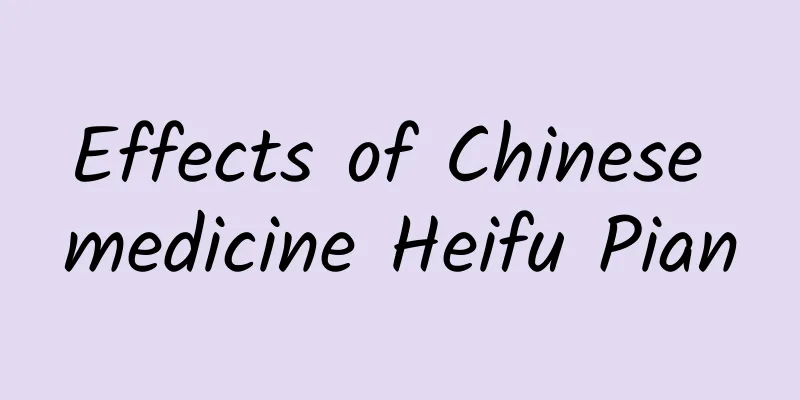What are the traditional Chinese medicines for promoting blood circulation and removing blood stasis during menstruation?

|
For female friends, if the menstrual blood is not flowing smoothly during the menstrual period, it is easy to have dysmenorrhea or other discomforts. Therefore, during the menstrual period, women can learn more about some blood-activating and blood-stasis-removing drugs. In this way, we can use these drugs to help ourselves activate blood circulation and remove blood stasis to better regulate the body and relieve various adverse problems during the menstrual period. 1. Achyranthes bidentata Achyranthes bidentata is a perennial herb. Its root is used as medicine. When used raw, it can promote blood circulation and regulate menstruation. It can treat postpartum abdominal pain, irregular menstruation, amenorrhea, epistaxis, toothache due to deficiency of fire, and edema caused by athlete's foot. When used cooked, it can nourish the liver and kidneys, strengthen the waist and knees, and treat soreness of the waist and knees, deficiency of the liver and kidneys, and pain caused by falls. Veterinarians use it to treat cattle's soft foot disease, broken bones from falls, etc. 2. Salvia miltiorrhiza Salvia miltiorrhiza is the dried root and rhizome of Salvia miltiorrhiza, a plant of the Lamiaceae family. Dig it up in spring and autumn, remove the mud and sand, and dry it. It has the effects of promoting blood circulation and removing blood stasis, promoting menstruation and relieving pain, clearing the heart and eliminating restlessness, cooling blood and eliminating carbuncle. It is used for chest pain, heart pain, epigastric and flank pain, accumulation of masses, pain due to heat, restlessness and insomnia, irregular menstruation, dysmenorrhea, amenorrhea, and swelling and pain of sores. 3. Peach kernel Peach kernel is the dried mature seed of peach or mountain peach of the Rosaceae family. The fruits are harvested when they are ripe, the pulp and shell are removed, the seeds are taken out and dried. It has the effects of promoting blood circulation and removing blood stasis, moistening the intestines and promoting bowel movements, relieving cough and relieving asthma. It is used for amenorrhea, dysmenorrhea, abdominal masses, lung abscess, intestinal abscess, injuries from falls, dry intestine and constipation, cough and asthma. The medicines introduced above can be very effective in helping to regulate some discomforts during women’s menstrual period. Therefore, in daily life, we should learn more about these common sense, so that we can help ourselves achieve the most ideal effect of promoting blood circulation and removing blood stasis and avoid more adverse injuries. |
<<: Benefits of Wild Polygonum Multiflorum Flower
>>: What are the effects of wild Polygonum multiflorum
Recommend
Drinking can prevent frostbite and warm the body? Don’t believe these 6 drinking rumors!
When eating, you can't help but drink a few g...
The efficacy and function of Artemisia argyi
The world is full of wonders, and Chinese medicin...
What are the hazards of applying Chinese medicine on the face
Traditional Chinese medicine is very popular nowa...
The efficacy and function of roxburghii flowers
Rosa roxburghii is a famous traditional Chinese m...
What are the general effects of the Chinese herbal medicine Alisma?
Chinese herbal medicine should not be unfamiliar ...
I felt hot after drinking too much, so how could I have hypothermia?
Expert of this article: Wang Xiaohuan, Doctor of ...
The efficacy and consumption methods of Angelica dahurica
There are certain requirements for the effects an...
What should you pay attention to when drinking Polygonum multiflorum soaked in water?
Polygonum multiflorum is a very important medicin...
Officially "surveying the sky"! Can "Mozi" on a 4,200-meter-high mountain help us see the universe clearly?
Today, at the Lenghu Astronomical Observatory in ...
The effect of soaking American ginseng in water on sexual function
Recently, many male friends have generally experi...
The efficacy of American ginseng and Ganoderma lucidum soaked in water
American ginseng and Ganoderma lucidum are two ve...
Specific medicine for treating urticaria
The methods and effects of treating urticaria var...
Can I drink Panax notoginseng powder in summer?
Panax notoginseng powder can be consumed in the s...
Can wolfberry replenish blood?
In daily life, we often find wolfberries in some ...
A great battle of the Winter Olympics gods, one picture teaches you how to distinguish all events!
Mixed Knowledge Specially designed to cure confus...









